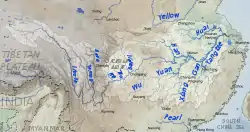Yangtze civilization
Yangtze civilization (simplified Chinese: 长江文明; traditional Chinese: 長江文明) is a generic name for various ancient Neolithic and Bronze Age cultures from the Yangtze basin of China, the representative civilization of the Chinese alongside the Yellow River civilization.

Yangtze basin
_by_Augustus_Binu.jpg.webp)
Asian rice, grown since the 9th millennium BC

Skeleton and burial vessels of the Qujialing culture (3400–2600 BC)
| Part of a series on the |
| History of China |
|---|
Cultures
Upper Yangtze
- Pengtoushan culture (7000–6100 BCE)
- Daxi culture (5000–3000 BCE)
- Qujialing culture (3400–2600 BCE)
- Shijiahe culture (2500–2000 BCE)
Lower Yangtze
- Hemudu culture (5500–3300 BCE)
- Majiabang culture (5000–3300 BCE)[1]
- Songze culture (3800–3300 BCE)
- Liangzhu culture (3300–2300 BCE)
- Wucheng culture (1600 BCE–?)
References
- Wang, Haiming (2001), "Majiabang", in Peregrine, Peter N.; Ember, Martin, Encyclopedia of Prehistory, Volume 3: East Asia and Oceania, Springer, pp. 206–221, ISBN 978-0-306-46257-3.
This article is issued from Wikipedia. The text is licensed under Creative Commons - Attribution - Sharealike. Additional terms may apply for the media files.